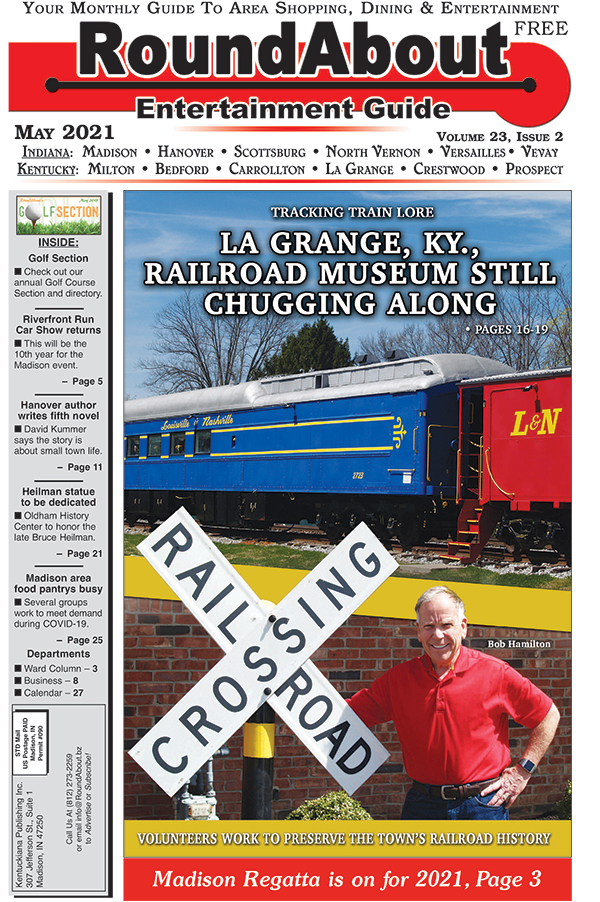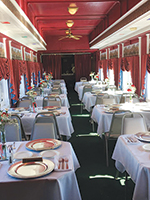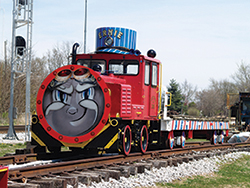



Tracking Train Lore
La Grange, Ky., Railroad Museum
is still chugging along
Volunteers work to preserve the town's railroad history
LA GRANGE, Ky. (May 2021) – La Grange is a town known for its railroad and a town fortunate to still have its original 107-year-old L&N Train Depot, located at 421 E. Main St. In an era when everything is computerized and digitalized, volunteers have managed to maintain and update the La Grange Railroad Museum and its surroundings to provide a fun and educational experience like no other.
 |
May 2021 Cover |
Even in the midst of the coronavirus pandemic, a small number of volunteers have achieved a great amount of work. The transformation over the last year has been “absolutely amazing,” said Bob Hamilton, the organization’s treasurer.
The museum, housed in the depot, was created by the Ohio Valley Railroad Historical Foundation as the vision of Bob Widman and others in the mid to late 1990s. It is now run by a volunteer board of directors that includes Chairman Will Hardin, Vice Chairman Len Dunman and Secretary Ava Spellman.
“The museum is operated and staffed 100 percent by volunteers,” said Hamilton, 71. The group has about 20 volunteers who have given countless hours to improve the museum and grounds for others to enjoy.
“In the past, we were open in summer and winter, and weekends only,” said Hamilton, a retired UPS pilot. “The museum is now open five days a week.” Future plans call for staying open seven days a week.
The group is always looking for volunteers to help with a variety of tasks. Hamilton said the ultimate goal is to have volunteers who will “come and give four to five hours once a month.” There are many opportunities for helping with displays, landscaping – and the list goes on.
 |
Photo by Helen McKinney The La Grange Train Depot serves as the site of the Train Museum. It is located at 421 E. Main St. in downtown La Grange. Volunteers have recently completed many upgrades to the building. |
Dunman said he “never knew anything about it” until he saw an article in a local paper looking for volunteers. “I became a board member and volunteer” while still working a full-time job.
Over the last year, volunteers “have done a lot of great things. We now have a lot more visitors,” he said. But volunteers are always needed as well as donations for the free museum to continue to operate.
Many of Dunman’s volunteer hours were spent working in the basement, helping set up train layouts, working on display cabinets and working outside trimming weeds and shaping up the grounds. He said volunteers “have fun doing it. There’s no pressure” to get things done.
Currently, members are working on an educational park that will be installed in a 40-foot square area located in front of a 1929 L&N Dining Car. This area will “provide more to do,” Hamilton said. City approval is needed to proceed.
The 83-foot dining car is a jewel in itself and was part of a series of 36-seat dining cars built by American Car & Foundry from 1921 to 1930. This L&N diner was in service on the Pan American between Cincinnati and Memphis and weighs 183,000 pounds.
 |
Photo courtesy A look inside the dining car shows the elegance of yesteryear. The dining car is available for weddings and other events at the Train Museum. |
The interior of the car contains its three original stainless steel sinks, a complete kitchen, restroom, seating and tables. For those who had the opportunity, eating on a train was a special experience since the tables were set with heavy china, real silver, crystal and linen. The L&N diners were known for their Old Hickory Smoked Country Ham with red-eye gravy and grits, Seafood Platter and Seafood Gumbo.
Prospect, Ky., residents Lynn and Bob Jones donated the dining car a few years ago. The dining car was converted to work-train service in the mid-1970s. The Joneses purchased it and used it for entertainment purposes, restoring it in 1991. The dining car, which can be rented for private events such as weddings and parties, operated on the tracks that now stand just a few feet behind it.
There is a lot to see and do for all ages at the museum. Volunteers have transformed the main level to include a variety of railroad artifacts and exhibits. The front lobby area was the original ladies waiting area, said Hamilton.
At one time the depot had a separate colored waiting room, main waiting area for white passengers, an agent’s room and ticket window – all areas that have been converted to tell the railroad’s history. The museum now contains a room dedicated to the Interurban Railway, an electric trolley system that played a major part in transportation and the growth of the county as well as the railroad. “We’ve placed things to tell a story,” Hamilton said.
The Louisville and Eastern Interurban Electric Railway train ran between La Grange and Louisville from 1902 to 1935, ending with the rising popularity of the automobile. The Interurban functioned largely as a commuter train with trains arriving and departing every hour. It also pulled a livestock car to allow farmers to transport their livestock to Louisville. The baggage car would often be loaded with milk and cream on its way to Louisville.
 |
Photo by Helen McKinney Ernie the Locomotive sits on a track outside the La Grange Train Museum. It is a popular attraction with children. |
The depot is owned by the City of La Grange. Hamilton said the group has been “working with the city to get better signage for people to find us.”
The lower level of the building houses the model railroad area where there is one main display of a model railroad. It contains 800 feet of HO scale track, a 150-year-old baggage cart and a Kids’ Room that has a 6x14-foot model railroad display layout.
There is also a workshop and classroom area to be used for “instructing classes for adults and kids about model railroading. When visitors come in, they get a history lesson,” said Hamilton.
Museum visitors will see railroad grade pocket watches, telegraph and signaling devices, and a variety of display cases filled with antique railroad memorabilia. “Everything has been donated,” he said.
Recently, Northland Corp. donated wood to refurbish an area of the depot and part of the interior of the 1963 caboose. “It is old, weathered, and in some cases it ranges from nearly new to barely useable – all untreated and a great gift to the museum,” said Hamilton.
Volunteer Ken Hoff said the museum has been “a shared vision.” He said he ran into Hamilton when he was at a point in the early retirement phase and looking for something to do that would help the community. “He got me interested.”
Since October 2020, Hoff has helped with cleaning, organizing, painting and repairing projects. “I’m an aviation guy, not a train enthusiast,” he said. “Having been a homeowner and farm boy, I like to fix things.”
Hoff said he thinks the museum “is a hidden jewel for the community. It’s consistent with the identity of La Grange being a railroad community in the past. Volunteers have made it pretty special.”
People will come from three to four hours away, said Hamilton, to see the train running down the center of town. “A lot of the traffic comes down I-71 and even other countries.” Up to 30 trains can pass through the city on an average day.
The museum receives very little funding on which to operate. Last year, a $2,000 grant was received from a foundation that prefers to remain anonymous, said Hamilton.
In 2020 more than 50 percent of nonprofits failed or were absorbed by others because of non-funding, he said. “We are financially stable because of the generosity of donors and through the rental of our dining car.”
The outside train display consists of the 1929 L&N Dining Car, a 1963 L&N bay window caboose donated by James Padgett Sr. of New Albany, Ind., and two rail units known as jitneys.
Also on permanent display is the Flying Duchess, a steam engine that created lots of interest when it was brought to town. It had been purchased by the Louisville Harrods Creek & Westport Railway Foundation before finding a home in La Grange.
The Flying Duchess was built in England in 1952 by the Robert Stephenson & Hawthorne Co. It was built on the same design as the famous children’s TV character, Thomas the Tank Engine.
The Flying Duchess was operational until it was sold in the early 1970s. The steam locomotive left the United Kingdom and was then shipped to the Boyne City Railroad in Grand Falls, Mich. When Boyne City failed, the Flying Duchess was sold and moved to Tennessee in the early 1980s. In 2000, the locomotive again was sold and moved first to Indiana and later to a scrap yard in Louisville before finally finding a new home in La Grange. Inmate labor was provided by the Kentucky State Reformatory to paint and refurbish these train cars.
Because motorists have to slow down to cross the tracks, the tracks themselves are a reminder of a slower paced era when time literally stood still for passing trains. The rails are embedded in the roadway pavement, so the trains share the street directly with pedestrians and automobile traffic. The speed limit for trains in the downtown area is 10 mph, forcing everyone on foot or car to slow down and take in the sight of a passing train.
Dunman said the museum “really represents a different time period. Few railroad stations are left especially in small communities. La Grange is really unique to have a railroad run through the middle of town. It’s a nice slice of history people don’t know about.”
• For more information or to volunteer, visit www.lagrangerailroadmuseum.org or call or call (502) 501-5100.
